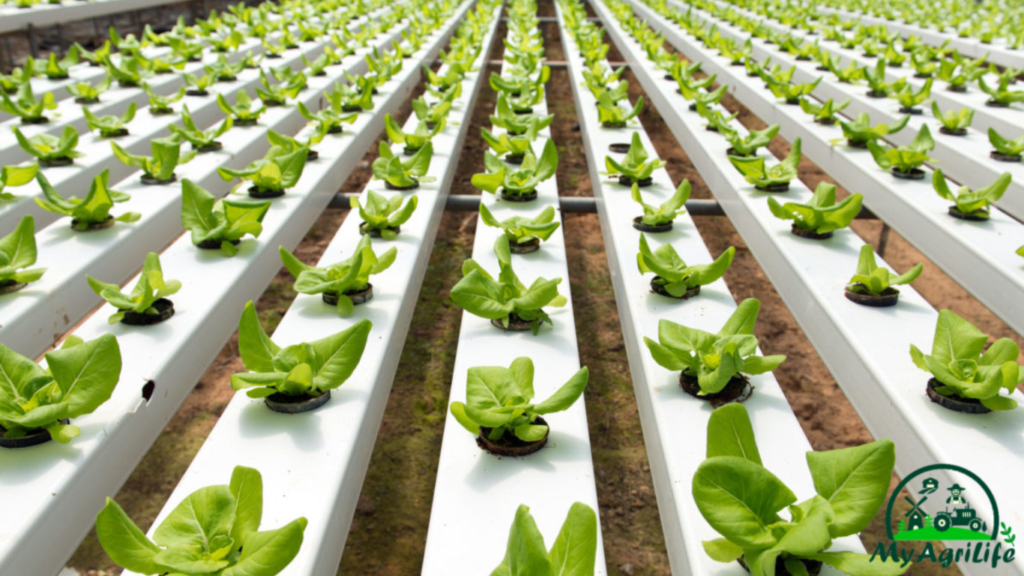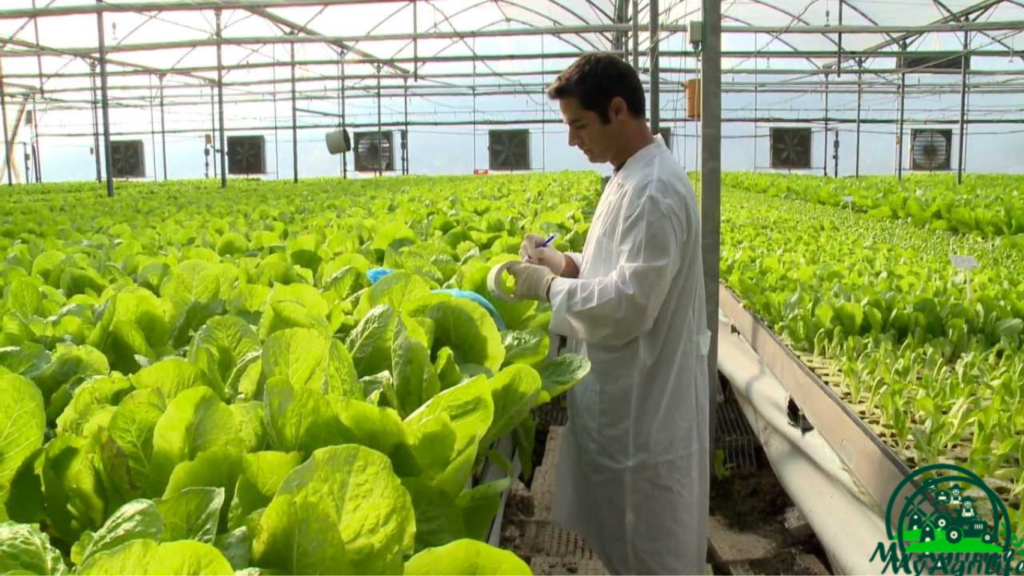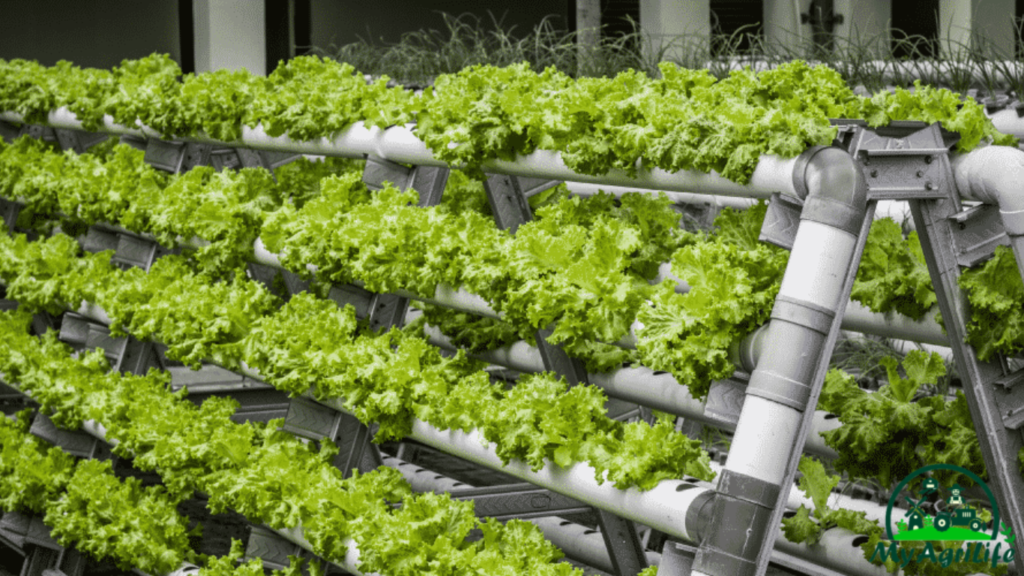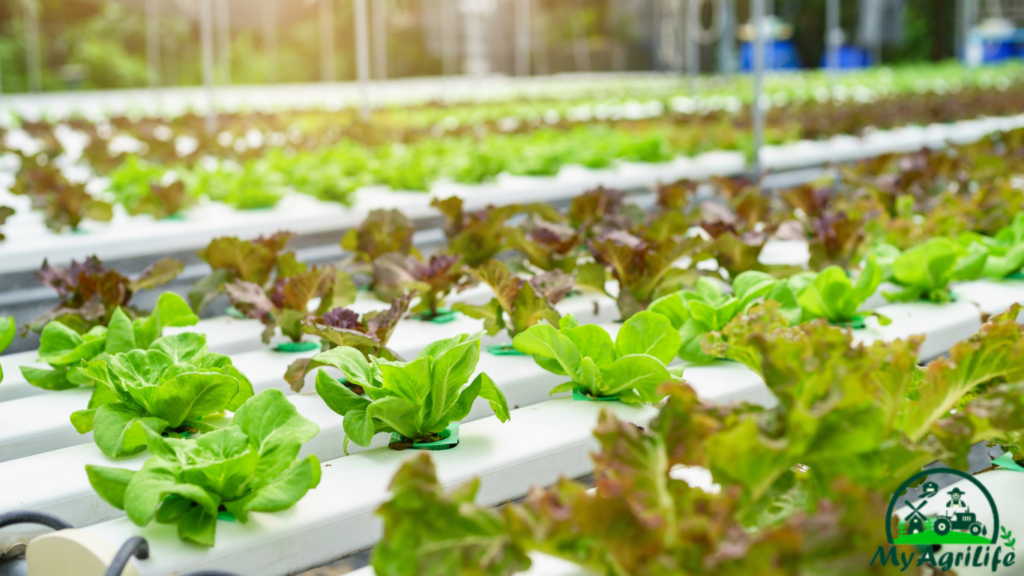
Hydroponics technology is a method of growing plants without soil, using nutrient-rich water solutions instead. This soilless technique of plant cultivation is gaining popularity in modern agriculture due to its numerous advantages, such as higher crop yields, water conservation, reduced land use, and the ability to grow crops in urban areas and regions with harsh climatic conditions.
In hydroponic systems, plants are grown in a controlled environment with a specific nutrient solution that is constantly circulated around the plant roots. The nutrient solution is typically made up of water and a mix of essential minerals that the plants need to grow, such as nitrogen, phosphorus, and potassium.
Hydroponic systems can be designed in various ways, including deep water culture, nutrient film technique, drip irrigation, and aeroponics. Each system has its own unique design and method of delivering the nutrient solution to the plants.
Hydroponics technology has been widely adopted in commercial agriculture, urban farming projects, and research and development, with potential applications in space exploration and other industries. However, there are also challenges associated with hydroponics technology, such as high initial investment, technical knowledge requirements, energy consumption, maintenance requirements, and limited crop diversity.

Overall, hydroponics technology offers a promising solution for promoting sustainable agriculture practices and addressing environmental challenges associated with traditional soil-based agriculture.
| Point | Description |
| 1.Definition | Method of growing plants without soil, using nutrient-rich water solution |
| 2.Israel’s expertise | Leader in hydroponic technology, with history of innovation |
| 3.Benefits of hydroponics | Year-round crop production, efficient use of resources, increased yields |
| 4.Innovative techniques in Israel | Vertical farming systems, computerized monitoring systems, sustainable agriculture solutions |
| 5.Crop applications in Israel | Tomatoes, cucumbers, lettuce, herbs, strawberries |
| 6.Sustainability benefits | Reducing use of harmful chemicals, conserving water |
| 7.Commercial and Home Use | Hydroponics technology can be used in both large-scale commercial farming operations and small-scale home gardening. |
| 8.Growing popularity | Hydroponics becoming increasingly popular worldwide |
| 9.Future outlook | Israel’s expertise likely to continue playing important role in industry growth and development |
| 10.challenges |
1.Definition
Hydroponics technology is a method of growing plants in a soil-free environment, using a nutrient-rich water solution to provide the necessary minerals and nutrients for plant growth. In hydroponics, the plant roots are placed in a growing medium, such as rockwool or perlite, and are periodically flooded with the nutrient solution.This allows for precise control of the plant’s growing conditions, including water, pH levels, and nutrient content, which can result in higher crop yields and more efficient use of resources compared to traditional soil-based agriculture. Hydroponics technology can be used for both commercial and home-based applications, and is becoming increasingly popular worldwide as a sustainable and efficient form of agriculture.
2.Israel’s Expertise
Israel is recognized as a world leader in hydroponics technology and has been at the forefront of developing innovative techniques and solutions for growing crops in arid and challenging environments. Israel’s expertise in hydroponics technology has been developed through decades of research and experience in dealing with water scarcity and arid conditions.

Some of the key factors that have contributed to Israel’s expertise in hydroponics technology include:
1.Pioneering research: Israeli scientists have been researching hydroponics technology since the 1950s, which has led to the development of innovative techniques and technologies.
2.Water scarcity: Israel is a country with limited water resources and has developed hydroponic techniques that allow for efficient water use and conservation.
3.Climate challenges: Israel’s hot and arid climate has forced growers to develop hydroponic solutions that can withstand extreme weather conditions.
4.Collaborative approach: Israel has a collaborative approach to research and development, which has allowed for the sharing of knowledge and expertise between researchers, growers, and industry professionals.
Overall, Israel’s expertise in hydroponics technology has allowed for the development of innovative and sustainable solutions for agriculture, and has the potential to address food security challenges in regions with limited water and arable land.
3.Benefits of Hydroponics
There are several advantages to using hydroponics technology for growing crops:

1.More efficient use of resources: Hydroponics uses less water and fertilizer than traditional soil-based agriculture. This is because the nutrient-rich water solution can be recycled and reused, and the precise control of growing conditions means that water and nutrients are delivered directly to the plant roots, reducing waste.
2.Higher yields: Hydroponic systems can produce higher crop yields compared to traditional soil-based agriculture, due to the precise control of growing conditions and the absence of soil-borne diseases.
3.Year-round crop production: Hydroponic systems can be used to grow crops year-round, regardless of weather or seasonal changes, which allows for more consistent crop yields and a more reliable supply of fresh produce.
4.Reduced use of harmful chemicals: Hydroponic systems can reduce the use of harmful chemicals, such as pesticides and herbicides, as the closed system means that pests and diseases can be more easily controlled.
5.Space-saving: Hydroponic systems can be designed to maximize the use of vertical space, allowing for higher crop yields in smaller areas.
6.Faster plant growth: Hydroponic systems can accelerate plant growth, as the precise control of growing conditions means that plants receive optimal nutrition and environmental conditions for growth.
7.Flexibility: Hydroponic systems can be adapted to suit different crop types and growing conditions, making them a versatile solution for agriculture.
Overall, hydroponics technology has the potential to revolutionize the way we produce food, by offering a more sustainable and efficient form of agriculture that can address food security challenges worldwide.
4.Hydroponics tecnology Innovative Techniques
There are several innovative techniques that have been developed in hydroponics technology, which have helped to improve crop yields and make hydroponic systems more efficient and sustainable. Some of these techniques include:

1.Vertical farming: This technique involves growing crops in vertically stacked layers, using artificial lighting to provide the necessary light for plant growth. This maximizes the use of available space and can result in higher crop yields per square meter of growing area.
2.Computerized monitoring systems: These systems use sensors to monitor the growing conditions of the plants, including temperature, humidity, and nutrient levels. This allows growers to make real-time adjustments to optimize growing conditions and improve crop yields.
3.Sustainable agriculture solutions: Hydroponic systems can be designed to use renewable energy sources, such as solar power, to reduce energy costs and minimize environmental impact. Additionally, some hydroponic systems can be designed to recycle and reuse water, further reducing water consumption.
4.Nutrient film technique (NFT): This technique involves a shallow stream of nutrient-rich water that flows over the plant roots, providing them with the necessary nutrients and oxygen for growth. The shallow stream of water also helps to cool the plant roots, which can improve plant growth in hot environments.
5.Aeroponics: This technique involves suspending the plant roots in the air and misting them with a nutrient-rich water solution. This allows for more oxygen to reach the plant roots, which can result in faster plant growth and higher crop yields.
Overall, these innovative techniques have helped to improve the efficiency and sustainability of hydroponic systems, and have made them a viable solution for agriculture in regions with limited water and arable land.
5.Applied Crops
Hydroponics technology can be used to grow a wide range of crops, including:

1.Leafy greens: Lettuce, spinach, kale, and other leafy greens are some of the most commonly grown crops in hydroponic systems. These crops are well-suited to hydroponic growing due to their fast growth rate and high water content.
2.Herbs: Basil, cilantro, parsley, and other herbs are also commonly grown in hydroponic systems, as they can be grown in relatively small spaces and have a high market value.
3.Tomatoes: Tomatoes are a popular crop for hydroponic systems, as they require a consistent supply of water and nutrients and are prone to soil-borne diseases.
4.Cucumbers: Cucumbers can also be grown in hydroponic systems, as they have a shallow root system and can be trained to grow vertically, maximizing space utilization.
5.Strawberries: Strawberries can be grown in hydroponic systems, allowing for year-round production of this high-value crop.
6.Microgreens: Microgreens, such as arugula, radish, and broccoli, can also be grown in hydroponic systems, as they require minimal space and have a fast growth rate.
Overall, hydroponic systems can be adapted to suit a wide range of crops and growing conditions, making them a versatile solution for agriculture. By using hydroponic systems to grow crops, growers can produce fresh, high-quality produce in regions with limited water and arable land, helping to address food security challenges worldwide.
6.Sustainability benefits
Hydroponics technology offers several sustainability benefits, making it an environmentally friendly solution for growing fresh produce. Some of the key sustainability benefits of hydroponics technology include:

1.Water conservation: Hydroponic systems use significantly less water than traditional soil-based agriculture, as the water is recirculated within the system. This means that hydroponic systems can be used in regions with limited water resources, reducing the demand for freshwater and promoting water conservation.
2.Reduced land use: Hydroponic systems can be designed to maximize space utilization, enabling growers to produce more food per unit of land than traditional soil-based agriculture. This can help to reduce land use and minimize the environmental impact of agriculture.
3.Reduced pesticide use: Hydroponic systems are less susceptible to pests and diseases than traditional soil-based agriculture, reducing the need for pesticides and promoting sustainable agriculture practices.
4.Energy efficiency: Hydroponic systems can be designed to use renewable energy sources, such as solar power, and can be designed to optimize energy efficiency, reducing energy consumption and minimizing environmental impact.
5.Reduced carbon footprint: Hydroponic systems can be designed to minimize carbon emissions by using renewable energy sources, optimizing energy efficiency, and reducing transportation requirements by producing food closer to consumers.
Overall, hydroponics technology offers several sustainability benefits, making it a promising solution for promoting sustainable agriculture practices and addressing environmental challenges associated with traditional soil-based agriculture.
7.Commercial and Home Use
Hydroponics technology can be used both for commercial and home use.

For commercial use, hydroponics systems can be designed to maximize crop yields and efficiency, making them an attractive solution for large-scale agriculture. Commercial hydroponic systems can be designed to grow a wide range of crops, including leafy greens, herbs, tomatoes, cucumbers, strawberries, and microgreens, and can be customized to suit specific growing conditions and crop requirements. Commercial hydroponic systems can be found in large-scale greenhouse operations, urban farms, and vertical farms.
For home use, hydroponic systems can be an attractive option for people who want to grow their own fresh produce but have limited space or access to arable land. Hydroponic systems designed for home use are typically smaller in scale and can be used to grow a range of crops, including herbs, lettuce, cherry tomatoes, and strawberries. Home hydroponic systems can be simple, DIY projects or can be purchased as ready-to-use kits from retailers.
Overall, hydroponics technology can be used for both commercial and home use, offering a versatile solution for growing fresh, high-quality produce in regions with limited water and arable land.
7.Potential Applications
Hydroponics technology has a wide range of potential applications in various fields, including:

1.Agriculture: Hydroponics technology can help to address food security challenges worldwide by enabling the production of fresh, high-quality produce in regions with limited water and arable land. Hydroponic systems can be designed to grow a range of crops, including leafy greens, herbs, tomatoes, cucumbers, and strawberries, and can be customized to suit specific growing conditions and crop requirements.
2.Urban farming: Hydroponics technology can be used in urban farming projects to produce fresh produce in urban areas, helping to address the problem of food deserts and providing access to fresh, healthy food for urban residents.
3.Sustainable agriculture: Hydroponic systems can be designed to use renewable energy sources, such as solar power, and can be designed to recycle and reuse water, reducing energy consumption and minimizing environmental impact.
4.Research and development: Hydroponics technology is used in research and development projects to study plant growth and nutrient uptake, as well as to test new crop varieties and growing techniques.
5.Space exploration: Hydroponics technology has potential applications in space exploration, as it can be used to produce fresh food in space habitats and on long-duration missions, reducing the need for resupply missions and improving astronaut nutrition.
Overall, hydroponics technology has potential applications in various fields, offering a versatile solution for growing fresh, high-quality produce in a range of environments and conditions.
8.Growing Industry

Hydroponics technology is a rapidly growing industry, driven by the increasing demand for fresh, high-quality produce and the need for sustainable agriculture solutions. The global hydroponics market size was valued at USD 2.43 billion in 2020 and is expected to reach USD 12.78 billion by 2028, with a compound annual growth rate (CAGR) of 22.6% during the forecast period (2021-2028).
The increasing adoption of hydroponic systems in commercial agriculture and urban farming projects is a key driver of market growth. Hydroponic systems offer several advantages over traditional soil-based agriculture, including higher crop yields, water conservation, and the ability to grow crops in regions with limited water and arable land. In addition, the increasing consumer demand for fresh, locally grown produce and the growing trend of vertical farming are driving the adoption of hydroponic systems.
The market for hydroponic systems is highly competitive, with several major players competing for market share. Key players in the industry include AeroFarms, BrightFarms, Freight Farms, Heliospectra AB, Koninklijke Philips N.V., and Signify Holding, among others. These companies are investing heavily in research and development to improve hydroponic system design, increase crop yields, and reduce operating costs.
Overall, the hydroponics industry is poised for continued growth in the coming years, driven by the need for sustainable agriculture solutions and the increasing demand for fresh, high-quality produce.
10.Hydroponics technology challenges
While hydroponics technology offers several advantages, there are also several challenges that need to be addressed for wider adoption and successful implementation. Some of the key challenges associated with hydroponics technology include:

1.High initial investment: Hydroponic systems can be expensive to set up and require significant upfront investment in equipment and infrastructure. This can be a barrier for small-scale growers and those with limited financial resources.
2.Technical knowledge: Hydroponics technology requires specialized technical knowledge in areas such as plant nutrition, water management, and system design. Lack of technical knowledge can result in system failure, reduced crop yields, and increased costs.
3.Energy consumption: Hydroponic systems require energy for heating, cooling, lighting, and water circulation, which can be a significant expense and contribute to greenhouse gas emissions.
4.Maintenance requirements: Hydroponic systems require regular maintenance to ensure optimal performance, including monitoring water quality, nutrient levels, and system cleanliness. Failure to maintain the system can result in reduced crop yields and increased costs.
5.Limited crop diversity: While hydroponic systems can grow a wide range of crops, some crops may be more difficult to grow hydroponically than others, limiting crop diversity.
Overall, while hydroponics technology offers several advantages, addressing the associated challenges is critical for wider adoption and successful implementation. This includes increasing access to technical knowledge and training, reducing initial investment costs, and improving energy efficiency and maintenance requirements.
conclusion
Hydroponics technology is a versatile and sustainable solution for growing fresh produce in regions with limited water and arable land. It offers several advantages over traditional soil-based agriculture, including higher crop yields, water conservation, and the ability to grow crops in urban areas and regions with harsh climatic conditions.
Israel has been at the forefront of hydroponics technology development and application, with advanced research, innovative techniques, and expertise in growing a wide range of crops. The technology has been applied in commercial agriculture and urban farming projects, with potential applications in space exploration and research and development.
The hydroponics industry is a rapidly growing market, with increasing demand for fresh, high-quality produce and sustainable agriculture solutions. The market is highly competitive, with major players investing heavily in research and development to improve system design, increase crop yields, and reduce operating costs.
Overall, hydroponics technology is a promising solution for addressing food security challenges worldwide and promoting sustainable agriculture practices. Its potential applications are vast and its growth prospects are significant, making it an important area for continued research and investment.









